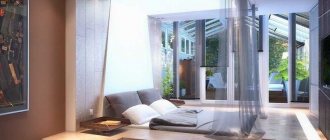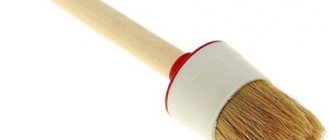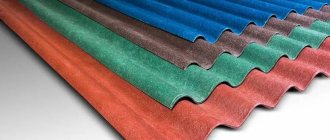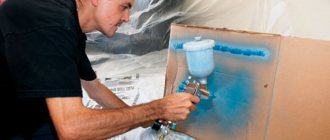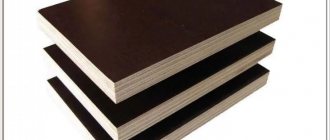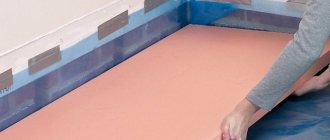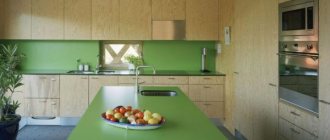One of the main tools for repairs is still a brush. A paint brush is an indispensable tool in modern repairs, even if we take into account the large selection of tools that are more convenient and technologically advanced.
Most often, brushes are used in household work, namely painting walls or other surfaces, applying wallpaper glue, and also used in furniture restoration.
To obtain the desired result, you need to choose high quality brushes. It is the quality of the brushes that will directly determine the progress of the work and its result.
Beam shape
There are brushes with flat and round beam shapes.
Professional painters most often choose flat paint brushes. Thanks to the elasticity of the working part, this brush makes it easy to work with liquid and thick compositions. The variety of bristle widths of flat brushes allows you to paint surfaces of any size.
But a flat brush is not always able to cope with its task. In such cases, use round brushes for painting. A brush with round bristles will help you easily paint window frames.
Functional tasks of brushes
When choosing brushes, it is advisable to keep in mind their level of functionality. Most often, tools are required to carry out the following work:
- applying glue for high-quality wallpapering;
- painting walls, flooring, doors;
- painting window structures and other premises;
- painting various furniture;
- painting benches installed in the garden.
In each case, brushes are needed for certain tasks, so when choosing, it is important to determine the degree of functionality and technical features of the painting tools.
Only if the right choice is made will there be a chance to evaluate the worthy performance of the work.
Bristle size
The next classification parameter is the size of the bristles. There are different sizes of paint brushes - narrow, medium, wide.
- Narrow brushes are those with a beam width of 1-3 cm. These brushes are convenient for painting thin elements and hard-to-reach places, drawing and applying decorative elements.
- Medium - brushes with bristles of 3.5 - 6 cm. Medium-sized brushes are used for painting doors, furniture, and window frames.
- Wide brushes usually have a width of 10 cm, so they are used for processing large surfaces.
What are the sizes of paint brushes?
- The paint brush must be selected correctly in size; not only the ease of use, but also the quality of the coated surface depends on this. With an unsuitable brush, after the surface dries, streaks, smudges or unnecessary protrusions beyond the required boundary may remain. In order to get a high-quality painted surface, you need to know what size brush is suitable for the selected material. Brushes can be of the following sizes: 25, 38, 50, 63, 75, 100 millimeters.
- Millimeters refer to the width of the bristles or stroke that remains after paint is applied. Brushes with the lowest rating are used for painting hard-to-reach areas. A wide pile is used for painting large areas.
- Brushes also differ in their pile; it can be made of natural or artificial fiber; the handle is made of wood or plastic material. Brushes of the Maklovitsa and radiator types can be used for using water-based materials.
- A brush with 25 millimeter bristles is used for painting narrow surfaces that are no more than 10 centimeters wide. That is, you can paint thin glazing beads, rods or other thin products.
- Brushes with a bristle width of 38 millimeters are used for round surfaces that have a circumference of up to 32 millimeters; such products can be baseboards or cornices, as well as various pipes.
- 50mm brushes are used for standard painting as well as items such as skirting boards, window frames, railings or steps.
- Brushes with bristles of 63 and 75 millimeters can be used for wide wood or metal products, painting walls, and other flat surfaces. Such brushes can be used for painting various utility structures, for example, greenhouses, fences, benches and benches.
- A brush with the widest bristles of 100 millimeters can be used for painting door panels, roofing materials, floors and other flat surfaces.
- Before you start work, you need to correctly decide on the choice of tool, taking into account the type of surface being processed and the type of paint used. For example, a brush with synthetic bristles is suitable for water-based formulations, as their bristles have the ability to repel moisture. Round brushes are suitable for painting small areas, while flat brushes are suitable for a flat surface. With the right tool selected, the painting material will lie evenly and be distributed over the entire surface, without leaving bubbles or smudges, and without protruding beyond the required boundaries.
Pile material
The brush bristle material can be natural, synthetic or combined.
Natural brushes contain animal hair, usually pig bristles, cow hair, and badger hair. Thanks to its split structure, natural hair can easily absorb paint, and due to its softness and pliability, natural brushes make painting simple and quick. These brushes are great for working with oil paint or drying oil.
Brushes made of synthetic materials also have a good ability to absorb paint. But if we compare natural and synthetic brushes, we can note that the latter will last much longer. These brushes are ideal for working with water-based paints.
A bundle of combined brushes combines natural and synthetic bristles. Thanks to this composition, the wear resistance of the bristles increases, and the hard bristles of the brush are able to easily hold paint.
What brush cannot be used to paint a surface?
The only thing that is not suitable for painting walls is the human hand. All other types of painting equipment are suitable for applying paint to the wall.
Attention
To paint a large area of the wall, it is better to choose a wide tool - this will speed up the application. Narrow brushes are useful for hard-to-reach areas and for creating decor.
Choosing a brush that is suitable for painting walls is not easy. The choice of bristle material and size matter. If you correctly take into account the nature and scale of the work and the type of paint, you can choose the right one without difficulty.
Area of application of brushes
It is also customary to divide paint brushes by area of application. Each type is accompanied by a photo of brushes for painting.
Hand brushes (HB) are the most popular type of brush. These brushes come in both flat and round bristles. They are used to apply glue, primer and paint on medium-sized surfaces.
Flat brushes (FB) are universal tools. They are used to paint surfaces of various sizes, apply glue, and also use them for decorative purposes.
Flute brushes (CF) are a flat brush with natural bristles. Due to their softness and elasticity, the bristles of flute paint brushes will help eliminate smudges caused by rougher brushes.
Fly tassels (FM) are large fluffy tassels with a wide tuft. These paint brushes are good for working with large surfaces - applying whitewash, washing the ceiling and walls. Swing brushes usually have a handle up to 20 cm in size, and they can also be mounted on a long stick, which will allow you to quickly apply material on large surfaces.
Paint brushes (KMA) are large brushes of flat or round shape. They usually contain natural horsehair and artificial bristles. The brush heads, thanks to their thick bristles, provide a large intake of material and distribute it evenly over large surfaces.
Filet brushes (KFK) have a small beam size, usually up to 2 cm. They are designed for working on small surfaces, painting hard-to-reach places, as well as for drawing out narrow strips (filets).
A crosscut brush (SC) is a hard and rigid brush. Thanks to its properties, trimming can add texture to a painted surface. This brush also does a good job of removing unevenness after other tools.
A brief overview of paint brushes
Different models are focused on a specific area of work. Taking into account such parameters guarantees the opportunity to make a worthy choice and perform quality work. Which tools are best? The answer to the question will be a brief overview based on classification.
Types of paint brushes are one of the most important questions that it is advisable to ask before carrying out the planned work.
Brush - handbrake
The main differences: large sizes, high-quality bristles, attached to a short handle. For maximum reliability, a metal rim is used.
It is important to note the possibility of tying individual fibers with twine, which creates a basis for convenient, complete work, regardless of what is recommended to paint the surface with.
Trimming brushes
Models called trims are used in situations where the painted surface must be rough and matte at the same time.
The most important rule: in any circumstances, the brush used must remain clean, so it is recommended to regularly moisten it, eliminating excess paint particles.
It is best to work according to the following scheme: careful and most targeted blows on the surface to be painted, because only in this case is the quality of the planned work guaranteed.
Maklovitz brush
The maklovitsa brush is made in round and rectangular shapes. In the first case, the diameter is 170 millimeters, in the second case – 200. Among the advantages it should be noted:
- maximum level of performance;
- the ability to perform painting work with the highest level of quality.
Maklovitsa brushes are best suited only for applying aqueous solutions.
Flying brush
Flying brushes are made in a round shape. Such models are recommended for almost all types of work, because they are distinguished, first of all, by a high level of functionality.
Moreover, there is the possibility of high-quality processing of a large area.
Swing brushes can be used even for those areas that are difficult to reach, and the additional use of long sticks is recommended.
File brushes
Panel models are made in the form of round and flat tassels. The diameter cannot exceed 18 millimeters.
It is advisable to use file brushes when drawing straight stripes and narrow lines during finishing work.
Radiator brush
Such models have a special design that is ideal for high-quality processing of hard-to-reach places.
It is assumed that batteries and other similar hard-to-reach areas can be successfully painted.
Brush care
In order for a new brush to last for a long time, it is necessary to follow certain rules for using and storing the tool.
Before use, new brushes should be washed with hot water and soap, which will clean the working part of dust and broken bristles. The same should be done with previously used brushes.
To obtain the correct shape of the bristles, before starting painting work, the brush should be developed. To do this, apply a small amount of the mixture with a brush onto a rough surface, such as brick or plaster.
If you plan to take a break, then leave the brush in the paint or in a special solution. In this case, the tool is not completely immersed, but only to the depth so that the hairs do not break. When working with glue, lime, oil and casein solutions, the tool is soaked in water.
When working with kerosene, turpentine or drying oil compositions, special solvents should be used. It is worth remembering that it is not advisable to leave wooden brushes in aqueous solutions, otherwise the bristle hairs may fall out.
Kerosene is used to clean paint brushes. Then the instruments should be washed in soap and water until the water becomes clear. Finally, the brushes are hung dried and stored in the same way.
Technique for dyeing small items
The best way to paint a product is to first disassemble it into individual parts . In this case, you need to decide in what order to paint the surfaces. Dovetailed drawer fronts are easier to paint when they are not already built into the side walls.
After filtering the color mixture into a separate clean container and, if necessary, selecting a suitable viscosity, saturate the brush. Try to pay attention to how much mixture the brush absorbs with each dip. And depending on the surface to be painted, adjust the amount of mixture in the brush.
Try to apply the paint mixture from the inside out, from top to bottom and from the panel to the lintels and uprights .
It is better to start painting the panels on the opposite side from you. In this case, if drops of paint fall on the surface, they can then be painted over along the way (which will be more difficult if you start painting from yourself, risking also getting dirty).
If it is convenient, you should apply the paint in the direction of the wood grain. The brush does not need to be tilted too much.
Making a pass, then we return to the beginning of the pass and begin to shade the coating . At the end, we change the direction of movement of the brush to the opposite, and where the first pass ended, we lightly move the brush perpendicular to the direction of the layer. This method is called leveling . It is preferred for painting stripes wider than the width of the brush.
Applying paint along the wood grain
How to choose a brush
When asking the question “which painting brush is best to choose?”, you need to decide on the type of work in which it will be used. When working with large surfaces, a brush is suitable, and for painting hard-to-reach places, a file brush is suitable.
The handle of the brush also plays an important role. If you need a lightweight and cheap tool, then you should choose brushes with a wooden handle.
But the plastic handle has a longer service life and wear resistance. Also, if you plan to use the brush repeatedly, then you should choose a tool whose beam is fixed with a brass element that is not susceptible to corrosion.
How to choose the right painting tool?
Choosing a tool for painting walls is very important. There are simple recommendations that, if followed, will minimize the likelihood of errors. You need to focus on the area to be painted and the type of paint coating.
- Since the wall area is usually significant, a hand brush or mackerel is chosen as the main tool to quickly process the main area.
- To process difficult areas - corners, the space behind heating radiators - it is convenient to use paneled, fluted or radiator.
- If you plan to treat walls with water-based paints, it is better to take tools with artificial bristles - they are more practical for such work.
- If you are going to varnish or apply oil paint, natural bristles are preferable.
Advice
Pay attention to the ergonomics of the handle: it should fit comfortably in your hand and not slip. Wooden handles are comfortable and familiar, while plastic handles are easier to clean from paint residues.

